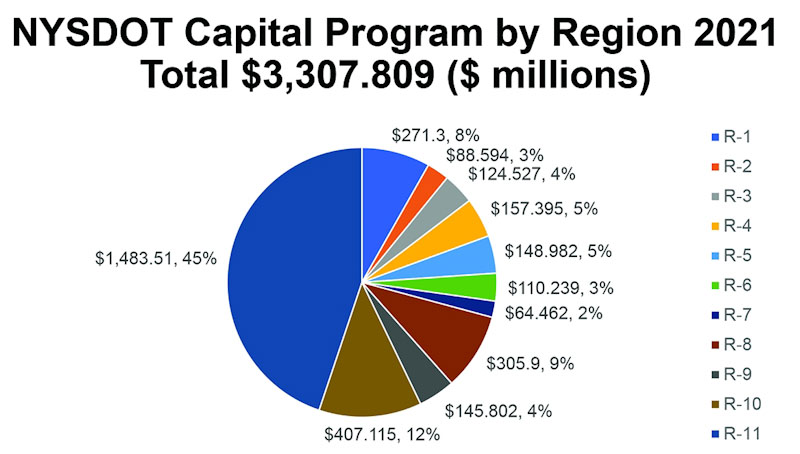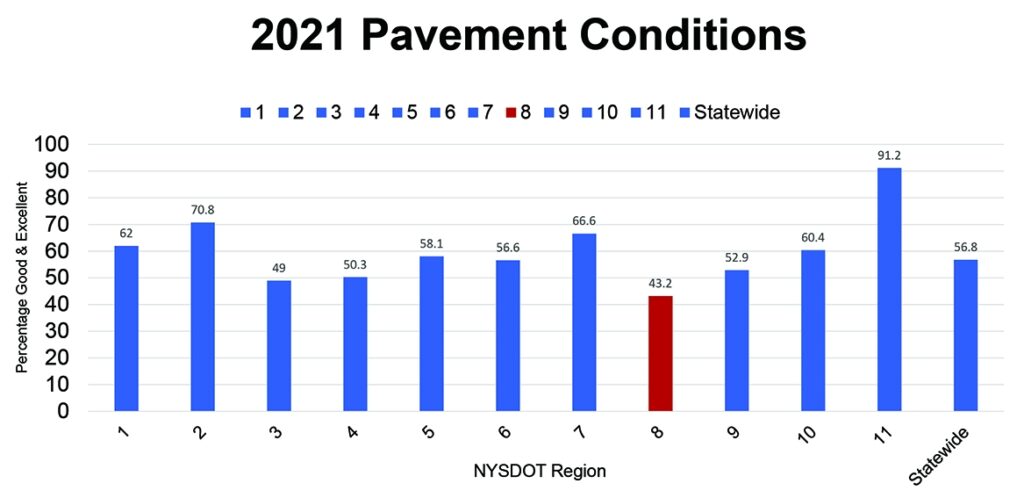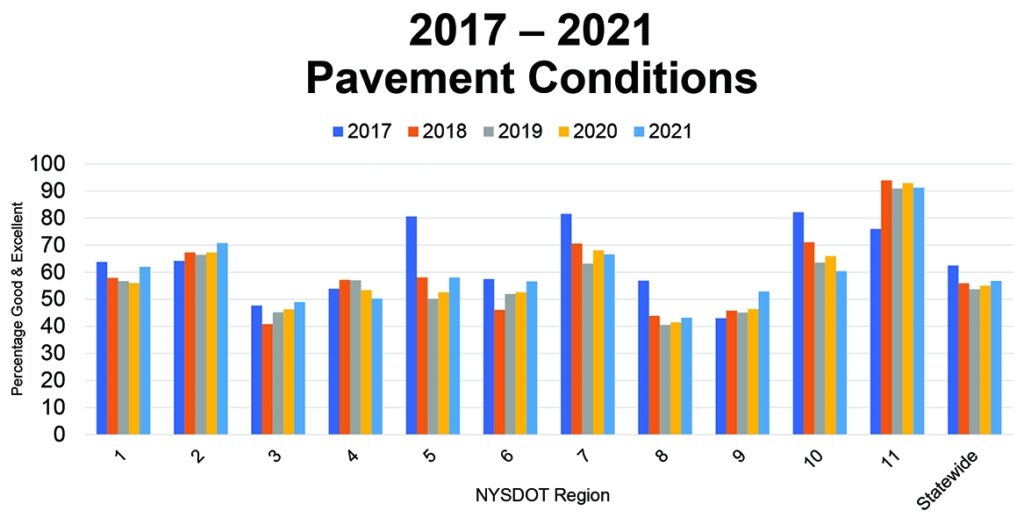PERSPECTIVE
Proposed NYS Executive Budget Falls Short On Transportation Funding for Mid-Hudson
By JOHN COONEY, JR
TARRYTOWN, NY—In the face of having the worst road and bridge conditions in New York State, why do the counties in the Lower and Mid-Hudson Valley receive less state funding than other NYSDOT regions despite having more lane miles and more bridges?
In 2021, more than half of state roads in Region 8 (56.8%) were rated in “fair” or “poor condition.” Compare that to conditions six years earlier when only a third of state roads in Region 8 (34.2%) were rated in fair/poor condition.
Bridges, too, have not fared well over the same six-year period. In the region where there are 2,260 state and local bridges, in 2021 some 43.8% of bridges were rated in fair/poor condition. That’s the equivalent of a 25% increase in deterioration since 2015 when just 32.1% of bridges in Region 8 were in fair/poor condition.
In fact, Region 8 has more bridges than any other DOT region in the state and maintains more bridges than New York City and Long Island combined. On a

statewide basis, besides having the worst bridge condition of any region, the Mid-Hudson Region also has the highest number of most deficient bridges, at 1,036. That’s 8% more than the statewide average (35.7%) of spans rated in fair/poor bridge condition.
Region 8 has both the most state and local lane miles of any NYSDOT Region in the state. The region maintains more than 5,000 more lane miles than any other region in the state. Region 8’s state pavements (there is no rating system for most local pavements) are rated the worst in the state—with a statewide average for fair/poor pavements at 43.2% and the Hudson Valley is a deplorable 56.8%, more than 5% more than the second-worse region at 51%.
How do we account for these deteriorating conditions? Certainly, the region has been a victim of underfunding for the maintenance and repair of our older infrastructure. Are the consequences of growth the unintended overuse of our transportation networks with unanticipated volume? Here’s a case that may help illuminate the need for more funding allocation to this region. The original Tappan Zee Bridge was designed to handle 80,000 vehicles daily. When it was finally retired in 2018, the span was carrying 140,000+ vehicles each day. We can pin this partly on the unique role the Hudson Valley plays both with its wide flung destinations for a larger-than-expected population and its pivotal role as the region serving as the thoroughfare to connect other parts of the state with the New York City metropolitan region.
Going forward, New York State is now in the second year of a five-year Capital Plan for NYSDOT totaling $32.8 billion. This incorporates a committed funding level in the upcoming FY2023-2024 budget of $6.97 billion. The state system inventory within the seven counties (Columbia, Dutchess, Orange, Putnam, Rockland, Ulster and Westchester) that make up Region 8 possesses nearly 24,000 lane miles on the local system and 5,449 lane miles on the state system managed by NYSDOT.
In light of these conditions that are continuing to decline, why does NYSDOT Region 8 and Westchester County receive less funding than other NYSDOT Regions despite having more lane miles, more bridges and the worst road and bridge conditions in New York State? The answer to that question would take a book to explain. But a solution is very simple:
Region 8 and Westchester County need a larger share of the overall annual funding dispersed by NYSDOT. Region 8 received $305.9 million, the equivalent of 9% of the overall statewide DOT Capital Program. Historically, NYSDOT Region 8’s overall percentage was and must return to 14% of the statewide capital program if we are to reverse this alarming deterioration.
There is a timely pathway forward for the Mid-Hudson region: Thanks to the Infrastructure Investment and Jobs Act (IIJA), New York State will receive some $4.6 billion in additional federal aid for highways and bridges over the next five years. This represents a 52% increase in federal aid. Further, only $2.6 billion of the $4.6 billion in additional federal highway aid is reflected in the governor’s NYSDOT Five-Year Capital Plan. We are calling on lawmakers in Albany to add an additional $2 billion of this federal funding this year to bolster the core NYSDOT program over the coming remaining four years of the Capital Plan.
And here’s the juicer: The state received $421 million of COVID stimulus money from the federal government to be used by NYSDOT. This money should be accounted for and reflected as an incremental increase to the overall NYSDOT Capital plan and to date has not.
With the overall conditions of New York State roads and bridges in decline—especially those in NYSDOT Region 8—it’s time to think bigger and take bold action. There will always be headwind, such as the inflation of the last two years raising costs, temporary supply chain shortages and the one-off advancement of needed “signature projects.” These short-term adversaries can be readily dispatched by the IIJA’s once-in-a-generation windfall to boost funding for the NYSDOT Core Program to improve the levels of safety and efficiency on our state highways, roads and bridges.


About the author: John Cooney Jr. is the Executive Director of the Construction Industry Council of Westchester & Hudson Valley, Inc. in Tarrytown, NY.
CIC Offers Six Recommendations to Advance Infrastructure Needs, Address Funding Shortfall
In testimony given before the Westchester State Delegation Public Budget Forum on Feb. 10, Construction Industry Council Executive Director John Cooney shared the CIC’s six-point recommendations to advance infrastructure renewal programs for municipalities and to adequately fund the NYSDOT Capital Program and Transportation Plan in the FY 2024 state budget.
- Expand Investment in Environmental Planning Grants (EPG), expand the EPG program to include a total of $6 million for communities that need help with wastewater or drinking/water projects;
- Increase investment in Asset Management Planning Grants, which the Environmental Facilities Corporation awarded last year, at $10 million, to help jumpstart asset management planning for a handful of communities across the state. An increased investment of $20 million will provide vital resources for small towns to effectively manage infrastructure investments;
- Increase the percentage share of the NYSDOT budget for Region 8 from the current 9% to its historic levels of 14% for its jurisdictional counties of Columbia, Dutchess, Orange, Putnam, Rockland, Ulster and Westchester;
- Allocate at least $2 billion of the increased federal aid authorized by the IIJA to the remaining four years of the NYSDOT Five-Year Capital Plan and dedicate this money to The Core NYSDOT Road and Bridge Program;
- Direct the $421 million of Covid Relief money received from the Federal Government to the NYSDOT Capital Plan as an incremental increase to the overall NYS DOT Capital Plan;
- Increase CHIPS/Marchiselli/Pave-NY/EWR/POP (Local Road Funding) by at least $150 million per year over the remaining four years of the program to compensate for the increased cost driven by inflation over the past two years.
